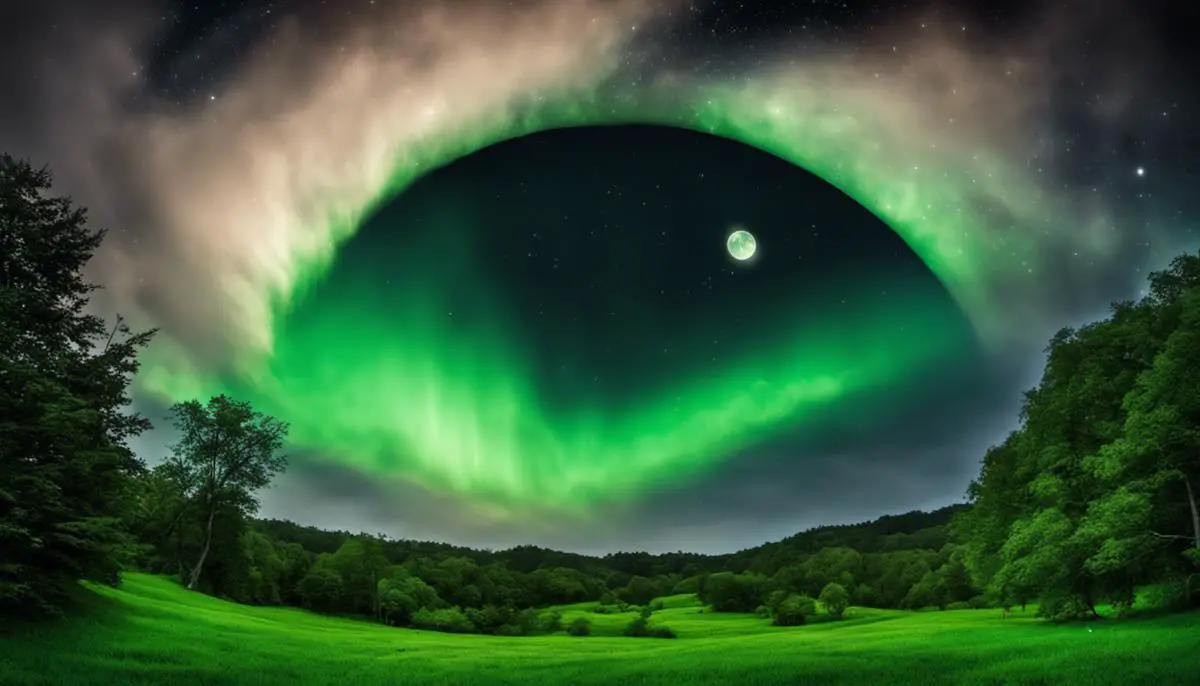For centuries, celestial bodies have allured people across cultures, providing us a sense of mysticism and leaving us ever fascinated. Among these, the ‘Green Moon’ stands tall as an intriguing astronomical concept, the understanding of which may not only satisfy our curiosity but also shed crucial insights into our understanding of the lunar calendar. With tales of its existence stretching across folklore and popular culture, the Green Moon has sparked considerable interest over time. This discussion, therefore, embarks on a nuanced journey through the understanding of the elusive Green Moon, its varied implications in science and cultures, as well as its potential alignment with the intricate ebb and flow of the lunar calendar.
Understanding a Green Moon
Understanding the Green Moon and Its Intriguing Characteristics
The celestial expanse that blankets our terrestrial abode has been an enigma since the dawn of discovery. Among the numerous celestial phenomena, the so-called ‘Green Moon’ harbors an interesting mixture of both scientific and cultural intricacies. A close and thoughtful inspection reveals that there is more to this hue-infused lunar occurrence than meets the eye.
The ‘Green Moon’, as it is colloquially referred to, is not a standalone celestial or astronomical entity per se, but a color-infused descriptor of our Moon under specific circumstances. These circumstances have spiritual and cultural implications more than they do astronomical or scientific relevancies.
To demystify the concept, ‘Green Moon’ primarily emerges from the context of folklore and imaginative cultural constructs. The moon does not physically transform into a green sphere in the sky, a notion that is inherently misaligned with known principles of astrophysics. Instead, the idea of a ‘Green Moon’ stems from viral internet hoaxes commonly seen on social media platforms, misleading those with untrained interest in astronomy.
However, it is worth noting that the moon can obtain a somewhat greenish tint in extremely rare circumstances, largely attributed to atmospheric conditions. A combination of smoke or dust particles in the Earth’s atmosphere can occasionally cause the moon’s color to fluctify, creating an illusion popularly known as ‘green moon’. Yet, it is unusually elusive and has not been widely photographed or documented.
The ‘Green Moon’ is sometimes also linked to certain cannabis culture expressions, with a ‘4/20 Green Moon’ gaining popularity due to a widespread internet meme that suggested the Moon would turn green on April 20th. The underlying connection arises from the fact that April 20th (4/20) is widely recognized as a countercultural day associated with cannabis.
Similarly, in some cultural contexts, a ‘Green Moon’ is correlated with the ‘Blue Moon’ phenomenon, a term used to denote the occurrence of two full moons within a single calendar month. The ‘Green Moon’ is then a metaphorical construct used to refer to an equally rare event. Nevertheless, unlike the ‘Blue Moon’, the ‘Green Moon’ lacks empirical evidence and recognizable frequency.
In conclusion, the concept of a ‘Green Moon’ presents an intriguing confluence of science, folklore, cultural ingenuity, and internet virality. While its existence differs within scientific reality and popular narrative, this unconventional lunar descriptor undeniably enriches the boundary-less folklore that encapsulates our celestial sphere. Through the lens of an astrophysicist or an astronomer, the ‘Green Moon’ serves as a phenomenon that highlights the ever-intricate dialogue between cultural perspectives and cosmic realities.
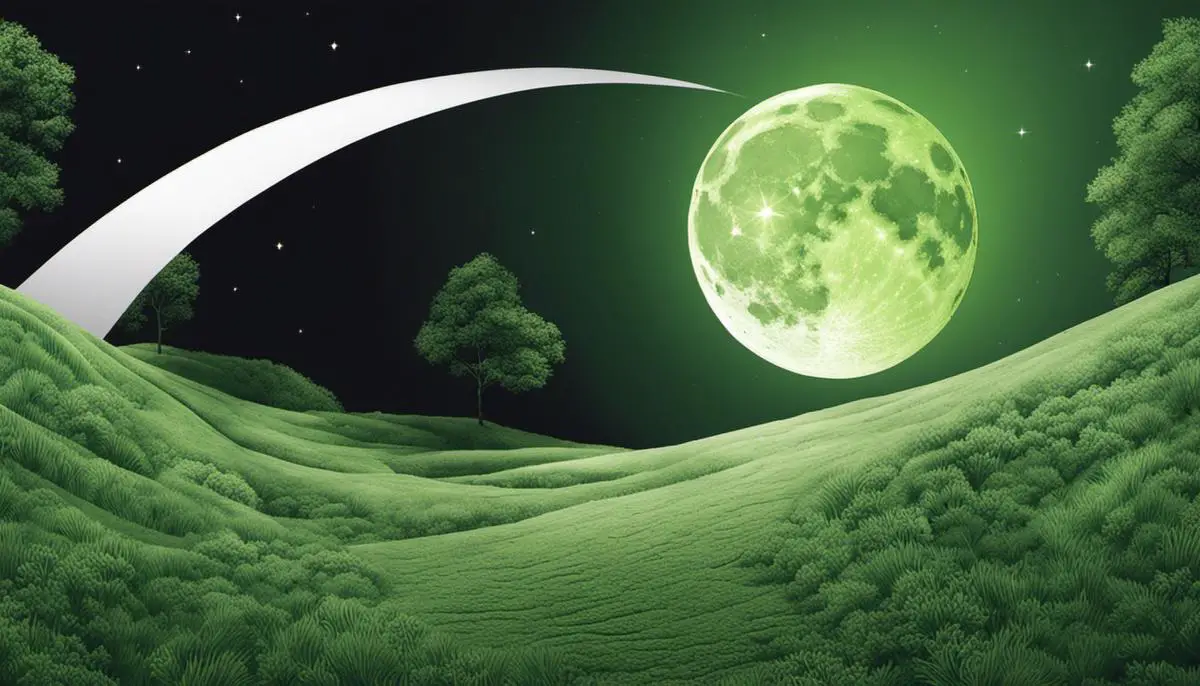
Scientific and Cultural Implications of a Green Moon
The Distortion of Light and the Perception of the ‘Green Moon’
It is plausible to postulate that atmospheric effects could, in theory, make the moon appear green. Light pollution, atmospheric dust or particles and even certain weather conditions can affect how we perceive the color of celestial objects. Moreover, dispersion of light – the same phenomenon that gives us the magnificent minion of colors in a rainbow – can, at times, tinge the moon with a greenish hue. As sunlight passes through our atmosphere, it gets refracted – or bent – by dynamic air layers of varying temperatures. This refraction splits the light into its component colors, and it’s theoretically possible for the green in this spectrum to dominate during specific conditions.
In the wake of the “4/20 Green Moon” meme, many imagined a lunar surface splashed with emerald hues, illuminating the night sky. As delightful as that image might sound to some, it’s essential to base our understanding of astronomical phenomenon on scientific truths rather than cultural or internet-imbued folklore. It is important to note, as is common knowledge within the astronomy community, that a moon the color of green verdure has never been scientifically documented.
In terms of cultural implications, the alleged “Green Moon” phenomenon served as a kaleidoscope through which societies across the globe tempered their scientific comprehension with cultural patterns. The dialogue fostered between the scientific integrity of astronomy and the compelling narratives of culture offers a rich tapestry of human intellect and ingenuity.
Resonant is the analogy with the “Blue Moon” phenomenon: a term now ubiquitously employed to talk about anything scarce or rare. The phrase, “once in a blue moon,” holds considerable cultural grip and yet, it bears little correlation to the actual hue of our lunar maiden. Rather, it refers to an additional full moon that appears in a subdivision of a year: either the third of four full moons in a season, or a second full moon in a month of the common calendar.
Juxtaposing the “Green Moon” with the phenomenon of a “Blue Moon” reflects on our ability to balance and bridge the polarities of empirical knowledge and cultural beliefs. This underscores how human interpretation, seen from either the collective cultural lens or the calculated gaze of science, shapes the significance we bestow on the universe’s celestial performances. After all, our understanding of the cosmos depends not only on what is actually ‘out there,’ but equally on how we perceive and interpret it down here.
Nevertheless, it remains imperative that we mustn’t let the whims of viral folklore overshadow, or even miscommunicate, the truths of the natural world. Therefore, it is crucial, as society immerses itself in the digital era, to promote a commitment to the accurate sharing and reporting of scientific phenomena, fostering a culture that values the pursuit of truth. Just as the moon guides sea tides with its faithful gravitational push and pull, so should our knowledge of it and the broader cosmos be led by the empirical light of science.
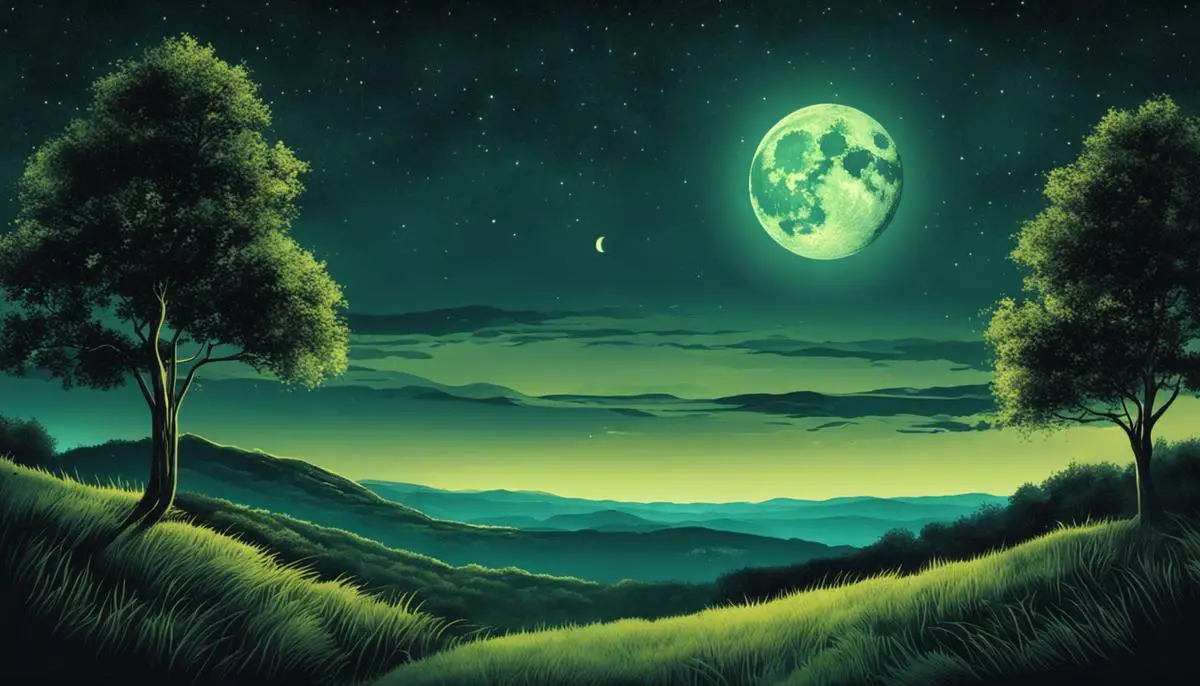
Basics of Lunar Calendar and its Relevance
Shifting our attention away from the intricate enigmas of the ‘Green Moon,’ the focus now gravitates towards understanding the concept of a ‘Lunar Calendar.’ This calls for a departure from folklore, culture, and memes, and delving into something empirical, reliable, and representative of the grand cosmic ballet that takes place above us each night.
Indeed, it is the Lunar Calendar, an age-old system with footprints smeared across numerous civilizations, that offers a precise, calculated approach to comprehend the prevailing artistic masterpiece that the moon paints in the canvas of the night sky.
A Lunar Calendar, quite simply, is a calendar that is based on the moon’s phases. It’s a system that elegantly intertwines the celestial and terrestrial, linking human civilization’s timescales with our natural satellite’s cyclical journey across the night sky. Unlike their solar counterparts, which have firm ties with the Earth’s orbit around the sun, Lunar Calendars choreograph their rhythmic dance alongside the moon’s visible cycles.
This calendar reflects Lunar Months, which encapsulate the time between two new moons or the period of the moon’s orbit around the Earth. By conventional measures, a lunar month consists of approximately 29.5 Earth days- a resultant of an intricate balance of celestial mechanics and Earth-moon dynamics.
While the lunar calendar’s roots run deep in ancient civilizations embracing its practicality, it is not bereft of any relevance in modern times. Indeed, Lunar Calendars hold substantial significance in a myriad of cultural, religious, and agricultural contexts.
Several present-day societies still abide by Lunar Calendars for determining significant events and festivals. Religion often intersects with astronomy here, and examples abound, such as the Islamic Hijri calendar or the Chinese, Hindu, and Jewish calendars, which implement a lunar-solar hybrid system.
Additionally, for agricultural societies and communities, the Lunar Calendar factors heavily into their farming activities and planning. Key events such as planting, harvesting, and various farming rituals align with particular lunar phases—a testament to the functional significance the moon holds, despite the technological advancements witnessed.
However, it is crucial to remember that while the Lunar Calendar’s practical applications may not permeate all facets of modern life, its metaphysical relevance endures. As a mirror reflecting our ancestors’ diligence and meticulous astronomical observations, it enables an understanding of our inner yearning to decode the cosmos. It serves as an instrument in bridging the temporal gulf and connects us with that primordial sense of wonder.
In essence, a Lunar Calendar is not just a chronological tool. It is a symbiotic concept, rooted equally in the physical realm of science and the subjective experience of ancient, as well as modern cultures. Amid the whirlwind of the modern era, it stands as a testament to our continuous attempts to understand, predict, and marvel at the celestial symphony that unfolds silently above us.
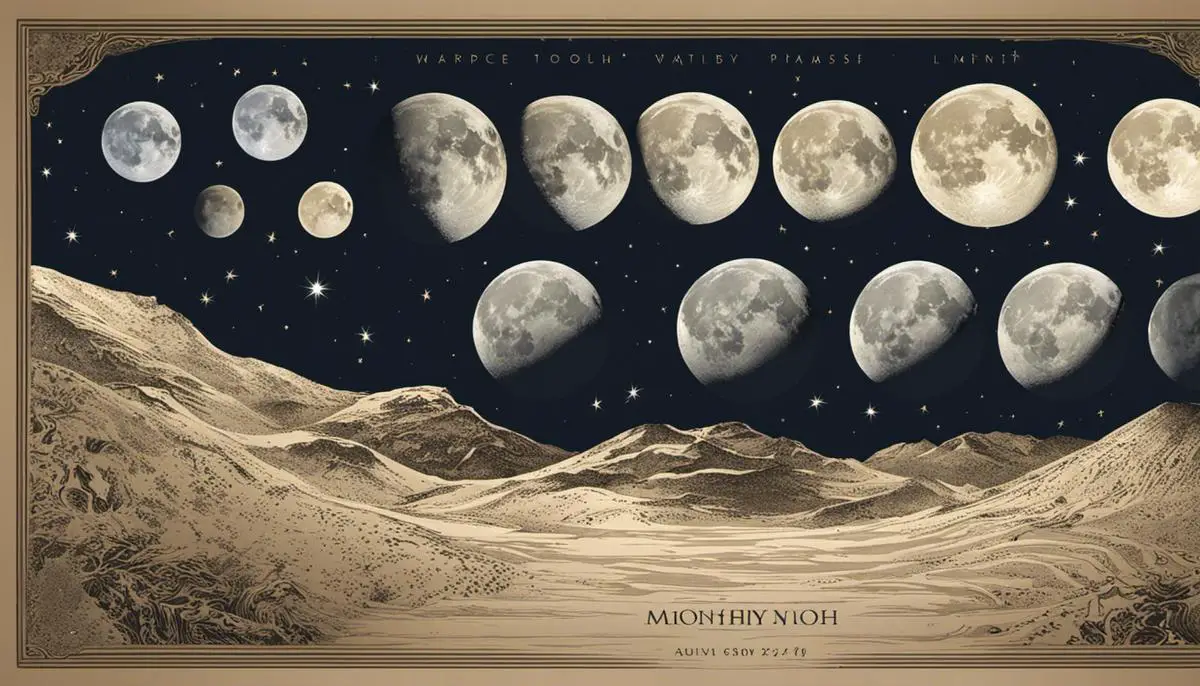
Connection between Green Moon and Lunar Calendar
Toward the lunar calendar’s function and its intricate relation to the “‘Green Moon'” controversy, it is incumbent to chart how these lunar cycles function.
A lunar calendar is constructed around the phases of the moon, namely the new moon, the first quarter, the full moon, and the last quarter. Compared to solar calendars, which are espoused predominantly in the modern Western world, lunar calendars invariably track the moon’s transformations—devoting approximately 29.5 days to a lunar month as contrasted to the solar calendar’s 30 or 31-day months.
Woven into the fabric of human history, lunar calendars’ antiquity extends to various ancient civilizations – from the Mesopotamians and Egyptians to the Druids, marking pivotal periods and occasions. Agriculture, an integral life-sustaining endeavor, has been dictated by the lunar calendar in numerous societies. For example, planting and harvesting have morphed into synchronized actions with lunar phases.
Present times also witness lunar calendars enshrined in religious and cultural frameworks. Notable examples include the Islamic Hijri calendar, Chinese, Hindu, and Jewish calendars, among others. These calendars architect the contours of numerous annual festivities, fasts, and rituals such as Ramadan for Muslims or Sukkot for Jews.
From an emblem of agricultural shifts to a sanctified cultural symbol, the profundity of lunar calendars in our lives still reverberates in a vibrant echo to our ancestors’ wisdom, forming an unbroken thread into the past. It underscores an enduring fascination with celestial phenomena—a star-studded symphony that ceaselessly unfolding before our very eyes.
The significant question thus arises: How does the lunar calendar intersect with the complex web of the “‘Green Moon'” controversy? The juxtaposition, at first glance, may seem non-existent. However, a deep understanding of astronomical phenomena and lunar calendars could inevitably lead to diverse perspectives. Relentless curiosity, the pursuit of truth, fascination with the cosmos combined with our embedded social construction could inevitably give birth to captivating narratives, such as the “‘Green Moon.'”
To summarize, the relation between the “‘Green Moon'” phenomenon and the lunar calendar crystallizes an intriguing intersection in humankind’s collective consciousness. It paints a broad canvas where folklore, atmospheric enigmas, cultural construct, and the digital explosion interact and breathe life into myths such as the “‘Green Moon.'” Thus, continually stoking the embers of human curiosity about the cosmos—calling forth an earnest endeavor to unravel the mysteries it hides.
In essence, the “‘Green Moon'” phenomenon and the lunar calendar embody a unique testament to the dynamic interplay between science and culture. From this perspective, the academic discourse succeeds not only in expanding the frontiers of our understanding but also illuminating the enduring human connection to the wondrous celestial symphony.
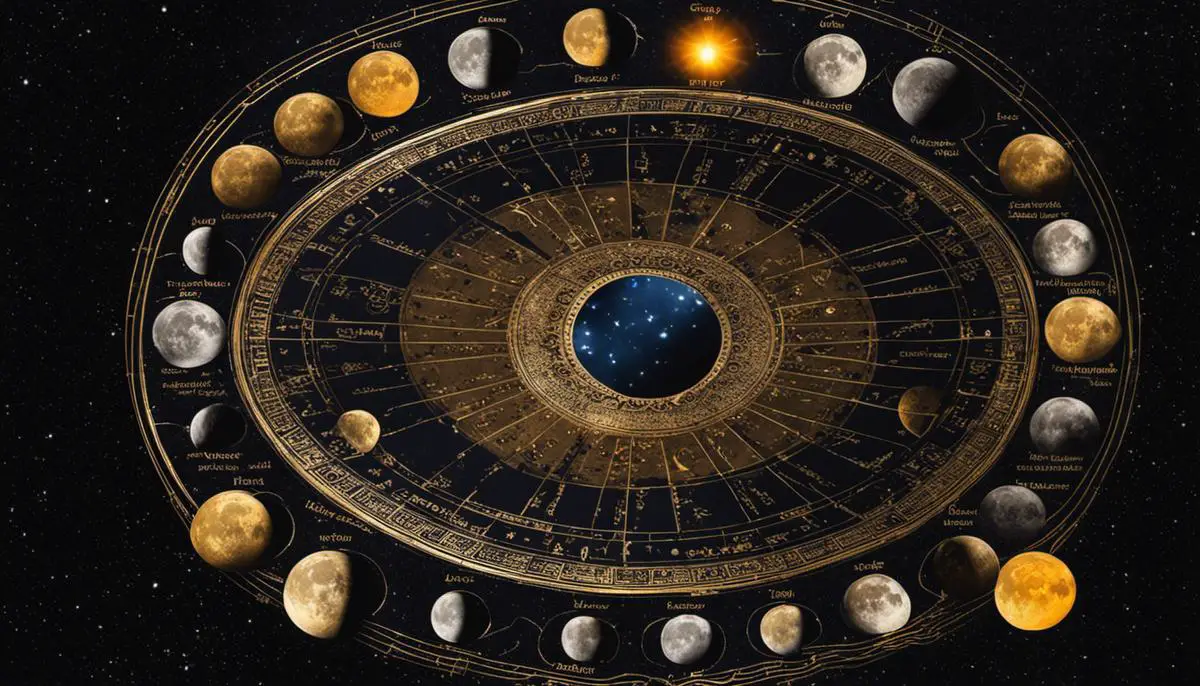
Our journey through the expansive universe of the Green Moon and Lunar Calendar reveals an intricate association between these two, stirring practical and cultural revelations. Scientific interpretations, folkloric tales, and cultural importance of the Green Moon, alongside the practical relevance and significance of Lunar Calendars, gives us a unified approach to viewing these cosmic phenomena. As we steer through our quest for knowledge, fostering a broader understanding about these aspects, we begin to appreciate their beauty and mysteries, getting a sense of our position in the larger cosmological scheme. Ultimately, the voyage into the celestial throws light on not only the intricacies of the lunar calendar or the mysteries of the Green Moon but also on the endless wonders that our universe holds within.
![]()
